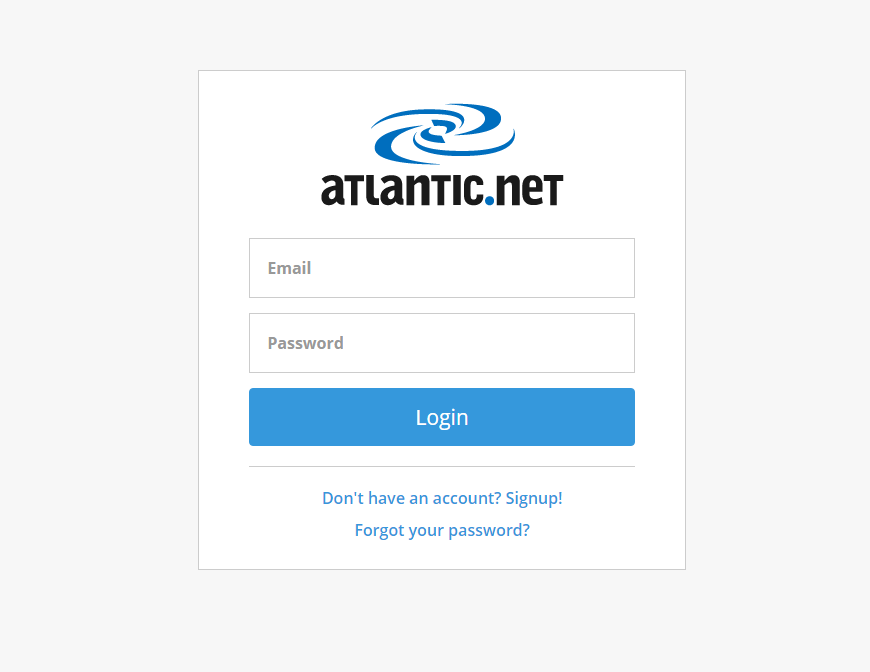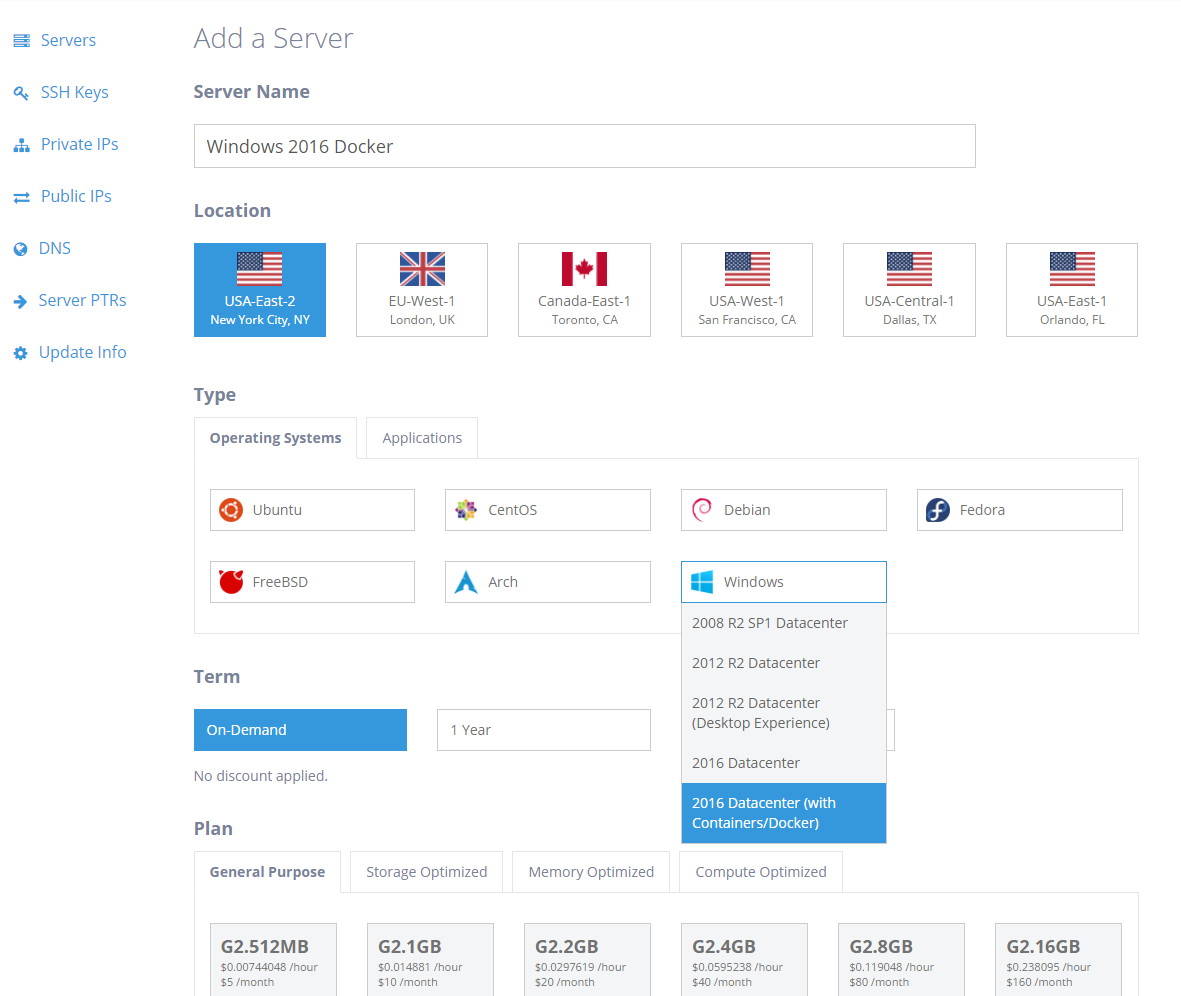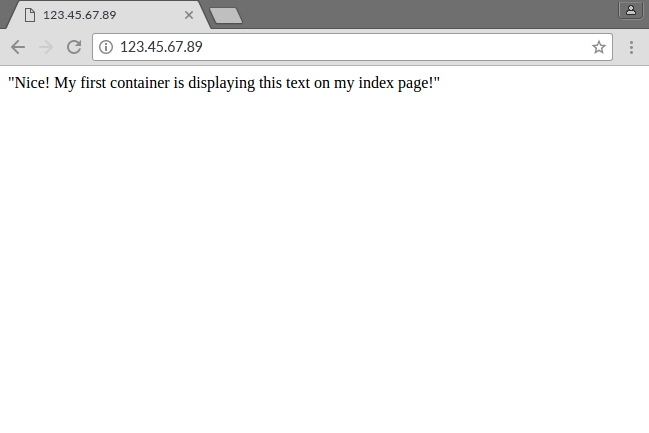Introduction
This article is a basic primer on how to use Windows Server 2016 with Containers and Docker on the Atlantic.Net Cloud. Docker popularized containers first on Linux, but now with Windows 2016, Windows containers are now natively supported as well. This means you can build your application in a container and ship it across your development and production environments knowing that it will work and run the exact same way on every device.
In this tutorial, we will deploy a web page in an IIS container from a Microsoft-distributed IIS container image. Let’s get started with a quick tutorial!
Deploying an Atlantic.Net Cloud Server
First, we need to deploy a new Windows 2016 with Containers VPS from the Atlantic.Net Cloud.
- Log in to https://cloud.atlantic.net.

- Click “+ Add Server.”
- On the “Add a Server” page, enter the following:
- Server Name: What you’d like your server’s name to be. For example, “Windows 2016 Docker.”
- Location: The data center you want your server created in.
- Type: Under the “Operating Systems” tab, select “Windows,” and then select “2016 Datacenter (with Containers/Docker).”

- Term: Do you want month-to-month, on-demand pricing, or do you want a one or three year term commitment for this server?
- Plan: We recommended at least a G2.2GB plan size for Windows-based servers, due to memory requirements.
- Enable Backups: Do you want your server backed up by us daily?
- Click “Create Server” to begin the provisioning of the server. The next page will have your login credentials for the new server displayed. Please save these somewhere so you can use them to log in. Note: The credentials will also be emailed to you.
Logging in to Windows 2016
Once the server is done provisioning, you will need to log into Windows 2016. Click here to find out how to remotely log in.
Checking Your Docker Version
Ensure that Docker is actually installed by running the “docker version” command from the Windows command prompt (cmd.exe).
C:\Users\Administrator>docker version Client: Version: 17.03.1-ee-3 API version: 1.27 Go version: go1.7.5 Git commit: 3fcee33 Built: Thu Mar 30 19:31:22 2017 OS/Arch: windows/amd64 Server: Version: 17.03.1-ee-3 API version: 1.27 (minimum version 1.24) Go version: go1.7.5 Git commit: 3fcee33 Built: Thu Mar 30 19:31:22 2017 OS/Arch: windows/amd64 Experimental: false
Running Your First IIS Container
The first step is to retrieve the Microsoft distributed IIS container. We could do this with the docker pull command (ie: docker pull microsoft/iis). However, in the interest of simplicity, we can skip this step and go straight to launching our first container. Docker will automatically pull down the necessary image (and any dependent images) if they don’t already exist locally.
Note: We are going to set some properties of the container when we run the command:
- Name: The name of the container. In this case, we would specify the name by entering “–name myIIS.”
- Ports: You can specify what ports you want open on the server. You do this by binding the internal ports of your container to an external port so it is accessible publicly. In this case, we are binding port 80 (the web port) of the container to port 80 of our Cloud Server with “-p 80:80“.
Docker will automatically pull down the necessary image (and any dependent images) if they don’t already exist locally.
C:\Users\Administrator>docker run -d --name myIIS -p 80:80 microsoft/iis Unable to find image 'microsoft/iis:latest' locally latest: Pulling from microsoft/iis 3889bb8d808b: Pull complete 6d4d50238ed1: Pull complete 0606d7d474d1: Pull complete 672755d284cd: Pull complete 88f5b9741695: Pull complete d53dd94c8474: Pull complete Digest: sha256:bcbcb3b442bc5f0ab3b8b769b52584d98751861b5e438b866d59287cc8112f10 Status: Downloaded newer image for microsoft/iis:latest 2614436cb74c8a21c77e071e13fb5937c12f8946ce8e3c7044e24216cae4100b
Your container is now running, which you can check with the following command:
C:\Users\Administrator>docker ps -a CONTAINER ID IMAGE COMMAND CREATED STATUS PORTS NAMES 2614436cb74c microsoft/iis "C:\\ServiceMonitor..." 4 days ago Up 4 days 0.0.0.0:80->80/tcp myIIS
Next, we will login to the container and start a Windows command prompt (cmd.exe) in the container to enter interactive commands:
C:\Users\Administrator>docker exec -i myIIS cmd Microsoft Windows [Version 10.0.14393] (c) 2016 Microsoft Corporation. All rights reserved. C:\>
Now that you are logged into the container, we are going to remove the default IIS web server start page so we can add our own index page:
del C:\inetpub\wwwroot\iisstart.htm
Now add your own content to the index.html page:
echo "Nice! My first container is displaying this text on my index page!" > C:\inetpub\wwwroot\index.html
Now open a browser and type in the IP address of your Cloud Server into the URL field. You should now see your index page:
Back in the CMD prompt, type exit to exit the interactive session of the container:
C:\>exit exit C:\Users\Administrator>
Building and Deploying a Docker Container with Your Changes
Now that the container is configured the way you want, you can save the container to a new container image for future use. First, we need to grab the name of the container from the “docker ps -a” command and stop the container:
C:\Users\Administrator>docker ps -a CONTAINER ID IMAGE COMMAND CREATED STATUS PORTS NAMES 2614436cb74c microsoft/iis "C:\\ServiceMonitor..." 4 days ago Up 4 days 0.0.0.0:80->80/tcp myIIS
C:\Users\Administrator>docker stop myIIS myIIS
Create the new container with “docker commit <current name> <new image name>“. In our case the current name is “myIIS“:
C:\Users\Administrator>docker commit myIIS configured-iis sha256:4d08b0a5561e11817d199d6d55d46497ce1d4221384d5c29b4c622d44cceed9c
Verify the new image has been created:
C:\Users\Administrator>docker images REPOSITORY TAG IMAGE ID CREATED SIZE configured-iis latest 4d08b0a5561e 44 seconds ago 10.5 GB microsoft/iis latest 9e66ceefdc5a 2 weeks ago 10.4 GB
The container we just created can now be deployed for future use:
docker run -d --name web01 -p 80:80 configured-iis
Now stop the new container and delete it:
C:\Users\Administrator>docker stop web01 web01
C:\Users\Administrator>docker rm web01 web01
Finishing Up
The above was just a basic tutorial. You can also do interesting things like automating the build of container images using DockerFiles, pushing the images to a centralized repository, and creating redundancy and automatic failover by having multiple nodes setup in a Docker Swarm. Enjoy!
